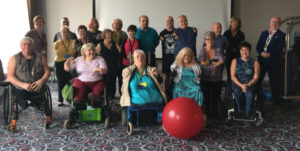 The Changing Health Of Thalidomide Survivors As They Age: A Scoping Review
The Changing Health Of Thalidomide Survivors As They Age: A Scoping Review
Elizabeth Newbronner, M.A. (Cantab), M.B.A
Aims
The aim of the review was to bring together, for the first time, the evidence about the thalidomide-related health problems thalidomide survivors are experiencing, as they grow older.
What was found
Twenty-five relevant papers were found. They included biomedical papers focusing on specific health problems, alongside surveys and mixed method accounts exploring the health of thalidomide survivors. Most studies had physical health as their primary focus.
The two most frequently reported groups of health problems were musculoskeletal and mental health conditions.
Themes
The key health themes reported in the 25 papers are summarised in the table below.
For each theme the author highlights the main issues experienced, and lists the relevant papers that give the details of the studies.
Click on a theme to view the relevant information.
Key Findings
Relevant Papers and Reports
Key Findings
- Musculoskeletal problems are the most common health issue amongst thalidomide survivors
- The prevalence and severity of musculoskeletal problems appears to increase with the severity of thalidomide survivor’s impairments but this relationship is not simple or linear
- Secondary damage to joints and muscles is primarily caused by ‘overuse’ and postural adaptations
- The pain and movement restriction caused by secondary damage is compounding existing impairments
Relevant Papers and Reports
Ref 12. Kennelly, C. Kelson, M. and Riesel, J. (2002). Thalidomide-impaired People: Quality of Life. The College of Health/Thalidomide Society.
Ref 14. Kayamori R (2013). Post-Thalidomide Syndrome 50 Years On. Japanese Journal of Rehabilitation Medicine. 2013; 50; 957-96.
Ref 20. Kruse A, Ding-Greiner C, Beckerr G, Stolla C, Becker A-M, and Baiker D (2013). Regular surveys on problems, special needs and care deficiencies of victims of Thalidomide – synopsis of final report presented to the Contergan Foundation for People with Disabilities. University of Heidelberg.
Ref 25. Meyers E M and Jutai J W (2011) The Disability Experience: Living with a Birth Defect Resulting from Thalidomide Exposure. Interdisciplinary Journal of Health Sciences 2 (2).
Key Findings
- Neuropathic pain and symptoms are more common amongst thalidomide survivors (including those with no Dysmelia) than the general population
- The causes of neuropathic pain and symptoms are disputed and often unclear
- Thalidomide survivors are more vulnerable to compressive neuropathies but these are hard to diagnose and treat
Relevant Papers and Reports
Ref 20. Kruse A, Ding-Greiner C, Beckerr G, Stolla C, Becker A-M, and Baiker D (2013). Regular surveys on problems, special needs and care deficiencies of victims of Thalidomide – synopsis of final report presented to the Contergan Foundation for People with Disabilities. University of Heidelberg.
Key Findings
- Thalidomide survivors have higher levels of decayed, missing and filled teeth, and tooth wear than the general population
- The causes of poorer dental health are multiple, including difficulties with dental hygiene, using teeth as tools and regurgitation
- The dental and facial health of thalidomide survivors is vulnerable
Relevant Papers and Reports
Ref 20. Kruse A, Ding-Greiner C, Beckerr G, Stolla C, Becker A-M, and Baiker D (2013). Regular surveys on problems, special needs and care deficiencies of victims of Thalidomide – synopsis of final report presented to the Contergan Foundation for People with Disabilities. University of Heidelberg.
Key Findings
- Thalidomide survivors are reporting deteriorating sight and hearing
- It is unclear whether this deteriorating in sight and hearing is thalidomide related or due to general ageing
- There is very little evidence about the extent and nature of deteriorating sight and hearing, and the impact on thalidomide survivors’ quality of life
Relevant Papers and Reports
Key Findings
- It is difficult to accurately measure blood pressure and body mass index when people have missing or short limbs and this make affect treatment/prevention difficult
- Some thalidomide survivors are aware that they are at risk of lifestyle related diseases but find their thalidomide impairment make it difficult manage their weight or exercise
- Hypertension may be more common amongst thalidomide survivors but more evidence is needed
Relevant Papers and Reports
Ref 33. Tajima T, Wada T, Yoshizawa A, Masuda T, Okafuji T, Nakayama T and Hasuo K (2016). Internal anomalies in thalidomide embryopathy: results of imaging screening by CT and MRI. Clinical Radiology 71 (2016) 1199.e1e1199.e7.
Key Findings
- Mental health problems appear to be more prevalent amongst thalidomide survivors than the general population
- Depressive disorders are the most frequently diagnosed or reported mental health problem
- The relationship between mental health and severity of impairment is unclear but thalidomide survivors with severe hearing impairment and facial damage appeared to be at greater risk of developing depression
- Other risk factors for poor mental health are similar to the general population and include poor social networks; living alone; unemployment; the need for on-going assistance; and recent experience of pain
Relevant Papers and Reports
Ref 20. Kruse A, Ding-Greiner C, Beckerr G, Stolla C, Becker A-M, and Baiker D (2013). Regular surveys on problems, special needs and care deficiencies of victims of Thalidomide – synopsis of final report presented to the Contergan Foundation for People with Disabilities. University of Heidelberg.
Ref 12. Kennelly, C. Kelson, M. and Riesel, J. (2002). Thalidomide-impaired People: Quality of Life. The College of Health/Thalidomide Society.
Importance of the project for people with thalidomide damage and Professionals
The literature about the health of thalidomide survivors as they age is not extensive. It is not of the highest level of scientific rigour and many of the biomedical studies have a narrow focus on specific conditions or pathologies.
Nevertheless, the studies in this review make an important contribution to an under researched area and together they do present a picture of the secondary damage people are now experiencing.
The 25 papers above, and the full reference list in the published article provide an important bibliography of available information on this issue at the present time.
The full published article can be viewed here:
Elizabeth Newbronner, M.A. (Cantab), M.B.A
The changing health of Thalidomide survivors as they age: A scoping review
You may also be interested in
Health and wellbeing survey

In depth survey of the health and wellbeing of UK thalidomide survivors, including problems faced

